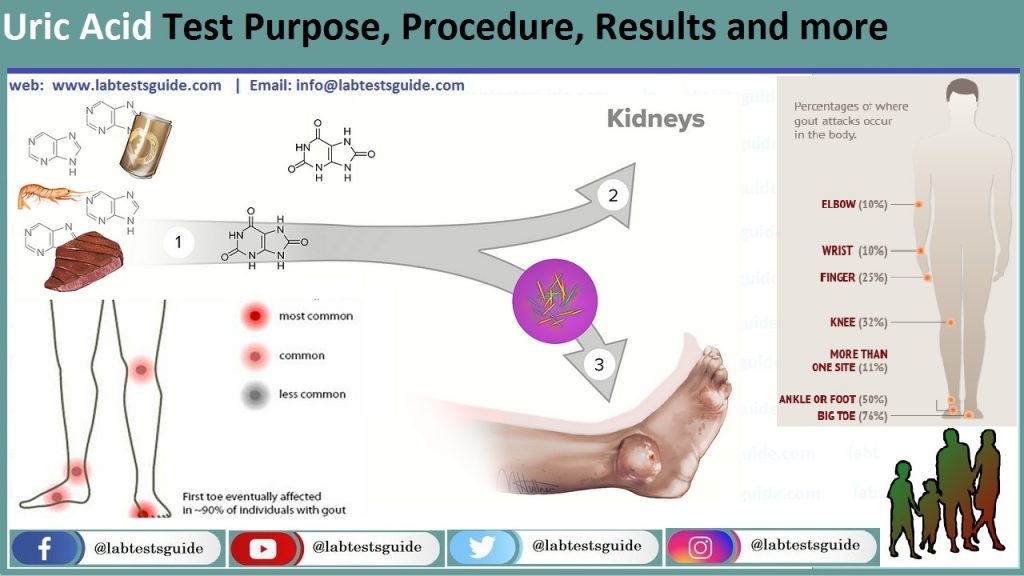This test measures the amount of uric acid in your blood or urine. Uric acid is a normal waste product that’s made when the body breaks down chemicals called purines. Purines are substances found in your own cells and also in some foods. Foods with high levels of purines include:
- liver
- Anchovies
- Sardines
- Dried beans
- Beer

Why to get tested:
A uric acid test is most often used to:
- Help diagnose gout
- Help find the cause of frequent kidney stones
- Monitor the uric acid level of people undergoing certain cancer treatments. Chemotherapy and radiation therapy can cause high levels of uric acid to go into the blood.
Why do I need a uric acid test :
You may also need a uric acid test if you have symptoms of gout. These include:
- Pain and/or swelling in the joints, especially in the big toe, ankle, or knee
- Reddish, shiny skin around the joints
- Joints that feel warm when touched
You may also need this test if you have symptoms of a kidney stone. These include:
- Sharp pains in your abdomen, side, or groin
- Back pain
- Blood in your urine
- Frequent urge to urinate
- Pain when urinating
- Cloudy or bad-smelling urine
- Nausea and vomiting
Physiology
- Uric Acid is a metabolic-by-product of purine catabolism
- Uricase converts Uric Acid to allantoin in most mammals, but is dysfunctional in humans
- Uric Acid varies considerably with purine and Alcohol intake, as well as Renal Function
Sample Required:
- Get the venous blood and prepare the serum.
- The serum is preferred but this test can be done on the plasma.
- A random sample can be used.
- Serum/plasma is stable for 3 to 5 days at 4 °C.
Precautions for Sample:
- EDTA and fluoride cause positive interference with the uricase method.
- Severe exercise increased the level of uric acid.
Normal
Source 1
| Age | Male | Fenmale |
| <12 years | 2.0 to 5.5 | 2.0 to 5.5 |
| 12 to 59 Years | 4.4 to 7.6 | 2.3 to 6.6 |
| 60 to 90 years | 4.2 to 8.0 | 3.5 to 7.3 |
| >90 years | 3.5 to 8.3 | 2.2 to 7.7 |
Source 2
- Male = 4.0 to 8.5 mg/dL
- Female = 2.7 to 7.3 mg/dL
- Old people = Values may be slightly increased.
- Child = 2.5 to 5.5 mg/dL
- Newborn = 2.0 to 6.2 mg/dL
Another source
- Male = 3.4 to 7.0 mg/dL.
- Female = 2.4 to 6.0 mg/dL.
- Children = 2.0 to 5.5 mg/dL.
- Hyperuricemia: most books defined the uric acid level:
- Men = > 7 mg/dL.
- Women = > 6 mg/dL.
- (Some of the books gives higher values)
Increased Uric Acid Level seen in:
- Gout.
- renal diseases and Renal failure, prerenal Azotemia.
- Alcoholism.
- Lead poisoning.
- Leukemia, Multiple Myeloma, Lymphoma.
- Starvation, weight-loss diets.
- Metabolic acidosis. and Diabetic ketoacidosis
- Toxemia of pregnancy.
- Liver diseases.
- Hemolytic Anaemia.
- Following excessive cell destruction, as in chemotherapy and radiation therapy.
- Lead poisoning.
- Alcoholism.
- Hereditary gout.
- Hyperlipidemia and obesity.
- Hypothyroidism.
- Hypoparathyroidism.
- Hemolytic anemias.
- Psoriasis.
- Glycogen storage disease.
- Increased ingestion of purines in diet e.g. liver, sweetbreads, kidneys, and anchovies.
- A genetic inborn error in purine metabolism.
- Metastatic cancers.
- Rhabdomyolysis e.g. Heavy Exercise, Crush injury, burns, epileptic seizure, and myocardial infarction.
Hyperuricemia Due To Decreased Excretion:
- Primary:
- Idiopathic.
- Secondary:
- Acidosis in diabetes and starvation.
- Hypothyroidism.
- Toxemia of pregnancy.
- Shock or chronic blood loss.
- Alcoholism.
- Hyperlipoproteinemia.
- Acute and Chronic renal failure.
- Lead poisoning.
- Salicylate due to low doses.
- Thiazide diuretics.
Decreased Level Of Uric Acid Seen In
- Fanconi’s syndrome
- Wilson’s disease
- Some malignancies like Hodgkin’s lymphoma and Myeloma.
- Deficiency of xanthine oxidase.
- Lead poisoning.
- Yellow atrophy of the liver.
- Salicylates in low doses.
- Thiazide diuretics.
- Increased renal reabsorption.
Treatment:
- Prevent the acute attack.
- Prevent the stone formation.
- The acute attack needs anti-inflammatory, non-steroidal drugs, and allopurinol.
- Colchicine is used in patients who can tolerate NSAIDs.
- Cortisone can be injected into the joints.
- Ice -packs may be applied to relieve the pain.
- The patient has advised a low purine diet.
- Intake of fluid is encouraged to increase urinary output.
- Antihyperuricemic drugs like Zyloric is given.
Possible References Used



